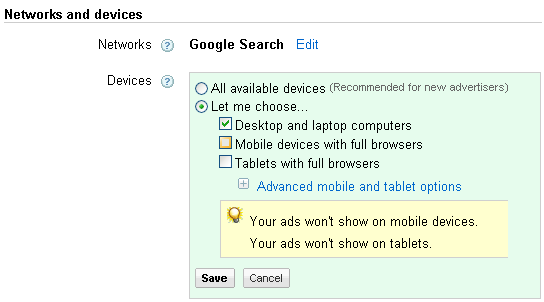 It seems nearly every day I read something new about the growing importance mobile search is beginning to play within our industry. With significantly higher click-through rates and reduced cost-per-clicks, targeting users on mobile devices via AdWords can be highly profitable if done correctly and is set to become an ever more important aspect of pay-per-click advertising.
It seems nearly every day I read something new about the growing importance mobile search is beginning to play within our industry. With significantly higher click-through rates and reduced cost-per-clicks, targeting users on mobile devices via AdWords can be highly profitable if done correctly and is set to become an ever more important aspect of pay-per-click advertising.
If you’re running PPC activity via AdWords directed at desktop, mobiles and tablets all from the same campaigns I would recommend a quick review of how your account is performing by viewing the account over its entirety and segmenting the data by device.
This can be done fairly easily going to the Campaigns tab in Adwords, then select the ‘Segment’ button and then select ‘Device’, like so:

If you have not done any optimisation work for mobiles then most likely the above will bring up some dramatic results and will show you both areas for improvement as well as opportunities for significant savings. Looking at the above data taken from an account I have recently started to manage, one can clearly see the dramatic difference in the performance of desktop traffic versus mobiles. It also shows me that advertising on mobiles would be worthwhile if done correctly, with over 13,000 impressions and a reduced cost-per-click.
If you’re looking at your own accounts and see similar results then I have put together some key areas you should be considering to help improve the performance of your pay-per-click advertising:
1. Campaign Segmentation
The nature of paid search for desktop versus mobiles is fundamentally different, with anything from the types of keywords you target to the bidding strategies you employ. In light of this the first thing I would recommend doing is splitting your account out by device so that you have one campaign for desktop and another for mobiles. Doing so will allow you to employ appropriate bidding strategies, create mobile targeted ad copy and allow you to track performance across devices far more easily.
If you already have a campaign running, I would recommend taking a copy of it and then exclude the applicable devices via the campaign’s ‘Settings’ tab like so:

The above will then only permit your ads to run on the devices you have selected.
2. Bidding Strategies & Average Ad Positions
On most mobile search results pages, paid results with an average ad position of one or two will be displayed at the top of a page giving you maximum exposure as on most devices these are the only results one will see without scrolling down. The next three paid search results are displayed at the bottom of the page, giving you little to no exposure. This is a fundamental difference when compared to desktop, where an ad with an average position of three or above usually gives you maximum exposure.
With this in mind, it is key that your ads have an average ad position of 2 or above to maximise your exposure – if your ads are constantly being displayed in position three or below then the likeliness of you achieving a click and thus a sale is pretty much non existent.
You will also have to ensure your site is optimised for mobiles and easily navigable, if users are clicking on your ads and are constantly bouncing as they find your site cumbersome to use then this is a signal to Google your site is not appropriate for mobile and your quality score will suffer. Instead of trying to buy your way into those top two spots, your budget would in my opinion be better spent developing a more mobile friendly site. This would help deliver a better experience to your potential clients and bring down bounce rates, which in the long term will improve your quality score and make obtaining a high average ad position for more easy and cost-effective.
3. Keyword Strategies
How people search is fundamentally different via a desktop versus a mobile device, most users on a desktop will be at home or work whilst those on mobiles will most probably be out and about. It is not uncommon for someone to search on a mobile whilst out shopping, they could be looking to compare prices online versus what they’ve found in a shop. Also the nature of the size of the device and screen on a mobile means that users very often will search with phrases of two to three words where on a desktop it could be much longer.
With the above in mind, don’t simply think you can just copy your existing campaign and then target it exclusively to mobiles. You need to think about the user and how different that person’s need is to go online. Therefore, I would recommend keeping the keywords you target short and a bit more generic with less of an emphasis on exact or phrase match. As you’re targeting more broad match keywords than you might do for desktop, I would recommend investing a significant amount of time building up an extensive list of negatives to cut down on waste on the account.
Well these are just a few of the key areas you should be looking at, if anyone else out there has any other suggestions or best practice it would be great to hear from you …
Image Source
Set of touchscreen smartphones via BigStock





Leave a Reply